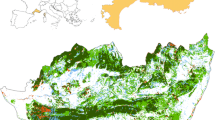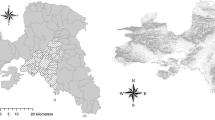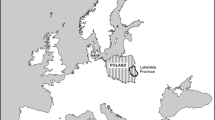Abstract
There is broad consensus that land use/cover has changed in central Europe over millennia. However, few studies have addressed the roles of the anthropogenic (socio-economic) and natural (biophysical) factors driving these changes over shorter periods (e.g., 100 years). In this study, we analyse the determinants of land cover composition at three discrete time periods (c. 1780, 1890, and 2000). We hypothesise that different anthropogenic and natural factors are the determinants of the main land cover types (arable fields, grasslands, and forests) and that the effects of natural and anthropogenic factors on the main land cover types differ among landscapes with highly dynamic and more stable forest-open land distributions. The study was carried out in the Uckermark region located in northeastern Germany. We compiled data on natural and anthropogenic factors (e.g. forest cover and number of inhabitants) of 65 municipalities in four landscape sections of equal size (10 × 10 km). Landscape sections were selected to reflect different dynamics (high/low) in conversion from forest to arable fields or grasslands and vice versa from 1780 to 2000. Averaged linear mixed-effect models explained between 7.5 and 81.2 % of the variance. The unique effect of anthropogenic factors varied from 2.1 to 18.7 % and that of natural factors varied from 0.2 to 43.4 %. In four of six models that included both types of factors, the natural factors were more influential than the anthropogenic factors. Except in three cases, anthropogenic and natural factors showed opposite effects on land cover types in more dynamic and more stable windows. Though the Uckermark region has been influenced by human activity for thousands of years, natural factors were a major determinant of land cover composition during all time periods, whereas anthropogenic factors became more important only during the latest time period under investigation.


Similar content being viewed by others
References
Ahrens WH, Cox DT, Budhwar G (1990) Use of the arcsine and square root transformations for subjectively determined percentage data. Weed Sci 38:452–458. http://www.jstor.org/stable/4044882
Andersen O, Crow TR, Lietz SM, Stearns F (1996) Transformation of a landscape in the upper mid-west, USA: the history of the lower St. Croix river valley, 1830 to present. Landsc Urban Plan 35:247–267. doi:10.1016/S0169-2046(96)00304-0
Antrop M (2005) Why landscapes of the past are important for the future. Landsc Urban Plan 70:21–34. doi:10.1016/j.landurbplan.2003.10.002
Aspinall R (2004) Modelling land use change with generalized linear models—a multi-model analysis of change between 1860 and 2000 in Gallatin Valley, Montana. J Environ Manage 72:91–103. doi:10.1016/j.jenvman.2004.02.009
Bamberg F (1909) Heimatkunde der Provinz Brandenburg nach natürlichen Landschaftsgebieten, vol 1. Friedrich Wilhelm Grunow, Leipzig
Bartoń K (2015) MuMIn: Multi-model inference. R package version 1.13.4. http://CRAN.R-project.org/package=MuMIn. Accessed July 2015
Bayerl G (2006) Geschichte der Landnutzung in der Region Barnim-Uckermark. Materialien der Interdisziplinären Arbeitsgruppe, vol 12. Zukunftsorientierte Nutzung ländlicher Räume, LandInnovation, Berlin
Bender O, Boehmer HJ, Jens D, Schumacher KP (2005) Using GIS to analyse long-term cultural landscape change in Southern Germany. Landsc Urban Plan 70:111–125. doi:10.1016/j.landurbplan.2003.10.008
Biró M, Szitár K, Horváth F, Bagi I, Molnár Z (2013) Detection of long-term landscape changes and trajectories in a Pannonian sand region: comparing land-cover and habitat-based approaches at two spatial scales. Community Ecol 14:219–230. doi:10.1556/ComEc.14.2013.2.12
Blackbourn D (2003) History of Germany 1780–1918. Blackwell, Oxford
Boeck R (1861) Ortschafts-Statistik des Regierungs-Bezirks Potsdam mit der Stadt Berlin. Reimer, Dietrich, Berlin
Bonilla-Moheno M, Aide TM, Clark ML (2012) The influence of socioeconomic, environmental, and demographic factors on municipality-scale land-cover change in Mexico. Reg Environ Change 12:543–557. doi:10.1007/s10113-011-0268-z
Bork HR, Bork H, Dalchow C, Piorr HP, Schatz T, Faust B (1998) Landschaftsentwicklung in Mitteleuropa. Klett, Perthes
Born M (1989) Die Entwicklung der Deutschen Agrarlandschaft. Wissenschaftliche Buchgesellschaft, Darmstadt
Bratring FWA (1805) Statistisch-topographische Beschreibung der gesammten Mark Brandenburg. Zweiter Band: Die Mittelmark und Uckermark enthaltend. Friedrich Maurer, Berlin
Burnham KP, Anderson DR (2003) Model selection and multimodel inference: a practical information-theoretic approach, 2nd edn. Springer, New York
Cabanillas FJJ, Aliseda JM, Gallego J (2012) Land cover and land use change in the central Spanish–Portuguese border region. Bol Asoc Geogr Esp 60:369–398
Cousins SAO (2001) Analysis of land-cover transitions based on 17th and 18th century cadastral maps and aerial photographs. Landsc Ecol 16:41–54. doi:10.1023/A:1008108704358
DWD (2013) Deutscher Wetterdienst (German weather service). http://www.dwd.de. Accessed November 2013
Enders L (1986) Historisches Ortslexikon für Brandenburg. Teil 8. Hermann, Uckermark Böhlaus Nachfolger, Weimar
Enders L (1992) Die Uckermark: Geschichte einer kurmärkischen Landschaft vom 12. bis zum 18. Jahrhundert, Böhlau, Weimar
Eurostat (2015) http://ec.europa.eu/eurostat/data/database. Accessed May 2015
Fidicin E (1864) Die Territorien der Mark Brandenburg oder Geschichte der einzelnen Kreise, Städte, Rittergüter und Dörfer in derselben als Fortsetzung des Landbuchs Kaiser Karl’s, Vol. IV. Bd. 4: Kreis Prenzlau. Kreis, Templin. Kreis Angermünde. Reprint in 1974, de Gruyter, Berlin
Fischer-Zujkov U, Schmidt R, Brande A (1999) Die Schwarzerden Nordostdeutschlands und ihre Stellung in der holozänen Landschaftsentwicklung. J Plant Nutr Soil Sci 162:443–449. doi:10.1002/(SICI)1522-2624(199908)162:4<443:AID-JPLN443>3.0.CO;2-7
Flade M (2006) Nature conservation in agricultural ecosystems. Quelle & Meyer, Wiebelsheim
Foster DR (1992) Land-use history (1730-1990) and vegetation dynamics in central New England, USA. J Ecol 80:753–772. doi:10.2307/2260864
Foster DR, Motzkin G, Slater B (1998) Land-use history as Long-term broad-scale disturbance: regional Forest dynamics in central New England. Ecosystems 1:96–119. doi:10.1007/s100219900008
Goldewijk KK (2001) Estimating Global Land use change over the past 300 years: the HYDE Database. Glob Biogeochem Cycles 15:417–433. doi:10.1029/1999GB001232
Goldewijk K, Ramankutty N (2004) Land cover change over the last three centuries due to human activities: the availability of new global data sets. GeoJournal 61:335–344. doi:10.1007/s10708-004-5050-z
Gränitz F, Grundmann L, Schmidt R (eds) (2008) Um Eberswalde. Chorin und den Werbellinsee, Böhlau, Köln
Grueber CE, Nakagawa S, Laws RJ, Jamieson IG (2011) Multimodel inference in ecology and evolution: challenges and solutions. J Evol Biol 24:699–711. doi:10.1111/j.1420-9101.2010.02210.x
Hagen WW (2002) Ordinary Prussians: Brandenburg Junkers and villagers. Cambridge University Press, Cambridge, pp 1500–1840
Hall B, Motzkin G, Foster DR, Syfert M, Burk J (2002) Three hundred years of forest and land-use change in Massachusetts, USA. J Biogeogr 29:1319–1335. doi:10.1046/j.1365-2699.2002.00790.x
Hawbaker TJ, Radeloff VC, Hammer RB, Clayton MK (2004) Road density and landscape pattern in relation to housing density, land ownership, land cover, and soils. Landsc Ecol 20:609–625. doi:10.1007/s10980-004-5647-0
Herzog F, Steiner B, Bailey D, Baudry J, Billeter R, Bukácek R, De Blust G, De Cock R, Dirksen J, Dormann CF, De Filippi R, Frossard E, Liira J, Schmidt T, Stöckli R, Thenail C, van Wingerden W, Bugter R (2006) Assessing the intensity of temperate European agriculture at the landscape scale. Eur J Agron 24:165–181. doi:10.1016/j.eja.2005.07.006
Hietel E, Waldhardt R, Otte A (2005) Linking socio-economic factors, environment and land cover in the German Highlands, 1945–1999. J Environ Manage 75:133–143. doi:10.1016/j.jenvman.2004.11.022
Houghton RA (1994) The worldwide extent of land-use change. Bioscience 44:305–313. doi:10.2307/1312380
IUSS Working Group WRB (2006) World reference base for soil resources 2006. World Soil Resources Reports 103. FAO, Rome
Iverson LR (1988) Land-use change in Illinois, USA: the influence of landscape attributes on current and historic land use. Landsc Ecol 2:45–61. doi:10.1007/BF00138907
Johnson JB, Omland KS (2004) Model selection in ecology and evolution. Trends Ecol Evol 19:101–108. doi:10.1016/j.tree.2003.10.013
Jones R (2005) A review of Land use/Land cover and agricultural change models. Stratus Consulting Inc. for the California Energy Commission, PIER Energy-Related Environmental Research. CEC-500-2005-056
Jongman RHG (2002) Homogenization and fragmentation of the European landscape: ecological consequences and solutions. Landsc Urban Plan 58:211–221. doi:10.1016/S0169-2046(01)00222-5
Klemm V, Darkow G, Bork HR (eds) (1998) Geschichte der Landwirtschaft in Brandenburg. Mezögazda, Budapest
Kluge U (2005) Agrarwirtschaft und ländliche Gesellschaft im 20. Oldenbourg Verlag, Jahrhundert, München
Koch HW (1978) A history of Prussia. Longman, London
Kölling B (ed) (1999) Agrarstatistik der Provinz Brandenburg 1750-1880. Quellen und Forschungen zur historischen Statistik von Deutschland. Bd. 25. Scripta Mercaturae Verlag, St. Katharinen
Lambin EF, Geist H (eds) (2006) Land-use and land-cover-change. Local processes and global impacts. Springer, Berlin
Landesumweltamt (LUA) (2007) In: Brandenburg (ed) Biotopkartierung Brandenburg. Bd. 1 Kartieranleitung und Anlagen, Bd. 2 Beschreibung der Biotoptypen. Brandenburgische Universitätsdruckerei und Verlagsgesellschaft, Potsdam
Legendre P, Legendre L (1998) Numerical ecology. Developments in environmental modelling 20, 2nd edn. Elsevier, Amsterdam
Lippstreu L, Hermsdorf N, Sonntag A (1997) Geologische Übersichtskarte des Landes Brandenburg, vols 1, 300. Erläuterungen, Potsdam
Melton E (2000) The transformation of the rural economy of east Elbian Prussia. In: Dwyler PG (ed) The rise of Prussia. Longman, Harlow, pp 1750–1830, 1700–1830, 111–128
Millington JDA, Perry GLW, Romero-Calcerrada R (2007) Regression techniques for examining land use/cover change: a case study of a Mediterranean landscape. Ecosystems 10:562–578. doi:10.1007/s10021-007-9020-4
Nakagawa S, Schielzeth H (2013) A general and simple method for obtaining R2 from generalized linear mixed-effects models. Methods Ecol Evol 4:133–142. doi:10.1111/j.2041-210x.2012.00261.x
Petit CC, Lambin EF (2002) Long-term land-cover changes in the Belgian Ardennes (1775–1929): model-based reconstruction vs. historical maps. Glob Change Biol 8:616–630. doi:10.1046/j.1365-2486.2002.00500.x
Pinheiro J, Bates D, DeRoy S, Sarker D, EISPACK authors (2015) Nlme: linear and nonlinear mixed effects models. R package version 3.1-121. http://CRAN.R-project.org/package=nlme. Accessed July 2015
Preußisches K (1905) Statistisches Landesamt. Gemeindelexikon für den Stadtkreis Berlin und die Provinz, Brandenburg
Ramankutty N, Foley JA (1999) Estimating historical changes in global land cover: croplands from 1700 to 1992. Glob Biogeochem Cycles 13:997–1027. doi:10.1029/1999GB900046
Ravichandran V (ed) (1999) Regional Land cover changes, sustainable agricultural and their interactions with global change. Universities Press, Hyderabad
Sakamoto Y, Ishiguro M, Kitagawa G (1986) Akaike information criterion statistics. Mathematics and its applications. Springer, The Netherlands
Schulze B, Quirin H, Heinrich G, editors (1969) Historischer Handatlas von Brandenburg und Berlin, Lfg. 26. Verwaltungsgliederung:1608-1806, 1:500.000. Veröffentlichungen der Historischen Kommission zu Berlin. De Gruyter, Berlin
Seidl A (2006) Deutsche Agrargeschichte. DLG-Verlag, Frankfurt am Main
Skånes HM, Bunce RGH (1997) Directions of landscape change (1741–1993) in Virestad, Sweden—characterised by multivariate analysis. Landsc Urban Plan 38:61–75. doi:10.1016/S0169-2046(97)00019-4
R Core Team (2015) R: a language and environment for statistical computing. R Foundation for Statistical Computing, Vienna, Austria. http://www.R-project.org. Accessed July 2015
Tian H, Banger K, Bo T, Dadhwal VK (2014) History of land use in India during 1880–2010: large-scale land transformations reconstructed from satellite data and historical archives. Glob Planet Change 121:78–88. doi:10.1016/j.gloplacha.2014.07.005
Zachwatowicz M, Giętkowski T (2010) Temporal changes of land cover in relation to chosen environmental variables in different types of landscape. Misc Geogr 14:33–45. http://depot.ceon.pl/handle/123456789/136. Accessed July 2015
Zak MR, Cabido M, Cáceres D, Díaz S (2008) What drives accelerated land cover change in central Argentina? Synergistic consequences of climatic, socioeconomic, and technological factors. Environ Manage 42:181–189. doi:10.1007/s00267-008-9101-y
Acknowledgments
The research was supported through basic funds in equal parts by the Federal Ministry of Food, Agriculture and Consumer Protection (BMELV) and by the Ministry for Science, Research and Culture of the State of Brandenburg (MWFK). We thank Ralf Wieland for running the models on a server with high processing power. The authors would like to thank two anonymous referee and Erica Smithwick for their thorough reviews and highly appreciate the comments and suggestions, which significantly contributed to improving the quality of the publication. Furthermore, we thank American Journal Experts for polishing our English.
Author information
Authors and Affiliations
Corresponding author
Additional information
Editor: Erica Smithwick.
Electronic supplementary material
Below is the link to the electronic supplementary material.
Rights and permissions
About this article
Cite this article
Wulf, M., Jahn, U. & Meier, K. Land cover composition determinants in the Uckermark (NE Germany) over a 220-year period. Reg Environ Change 16, 1793–1805 (2016). https://doi.org/10.1007/s10113-016-0930-6
Received:
Accepted:
Published:
Issue Date:
DOI: https://doi.org/10.1007/s10113-016-0930-6




